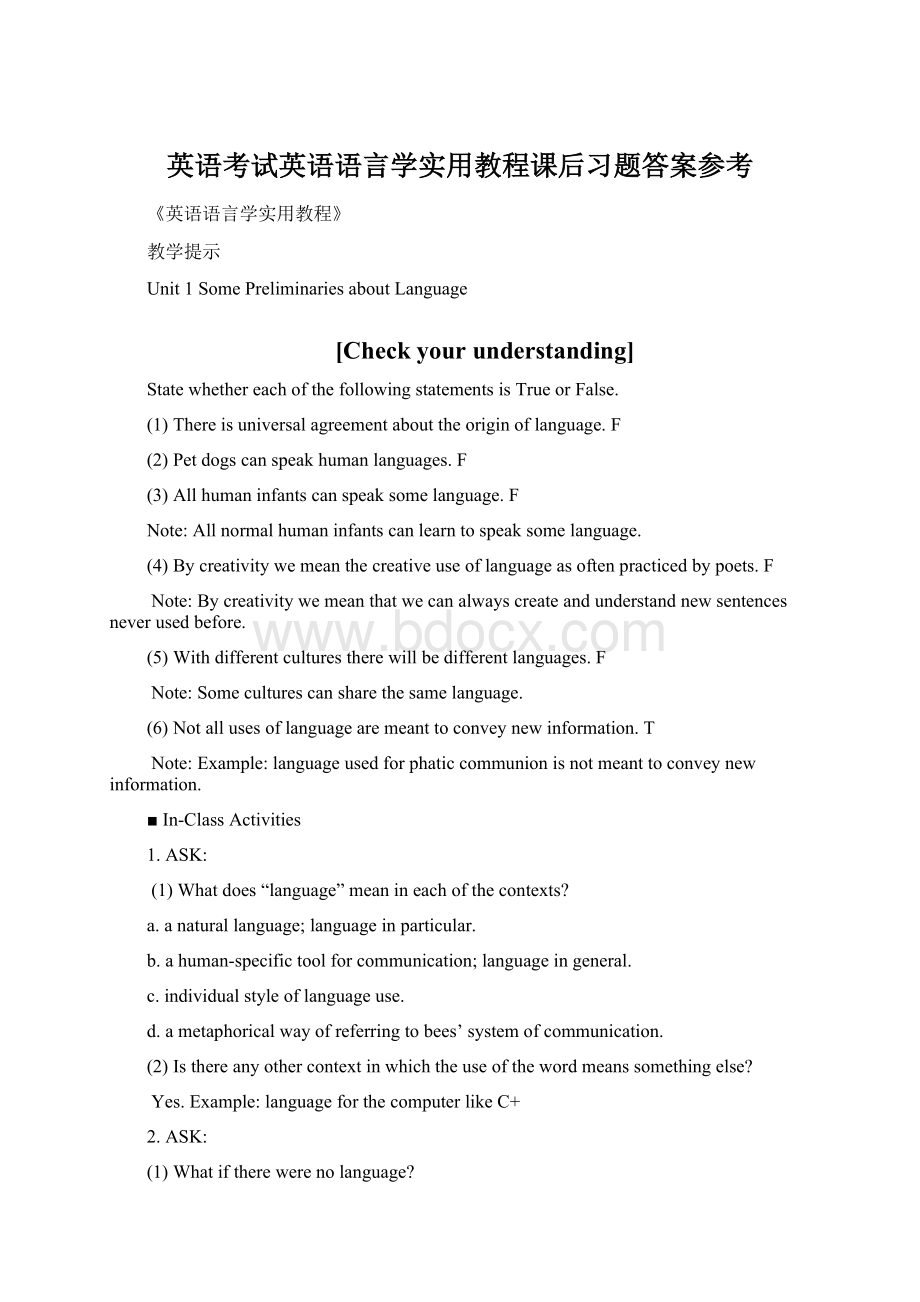英语考试英语语言学实用教程课后习题答案参考文档格式.docx
《英语考试英语语言学实用教程课后习题答案参考文档格式.docx》由会员分享,可在线阅读,更多相关《英语考试英语语言学实用教程课后习题答案参考文档格式.docx(74页珍藏版)》请在冰豆网上搜索。

Note:
Allnormalhumaninfantscanlearntospeaksomelanguage.
(4)Bycreativitywemeanthecreativeuseoflanguageasoftenpracticedbypoets.F
Note:
Bycreativitywemeanthatwecanalwayscreateandunderstandnewsentencesneverusedbefore.
(5)Withdifferentculturestherewillbedifferentlanguages.F
Someculturescansharethesamelanguage.
(6)Notallusesoflanguagearemeanttoconveynewinformation.T
Example:
languageusedforphaticcommunionisnotmeanttoconveynewinformation.
■In-ClassActivities
1.ASK:
(1)Whatdoes“language”meanineachofthecontexts?
a.anaturallanguage;
languageinparticular.
b.ahuman-specifictoolforcommunication;
languageingeneral.
c.individualstyleoflanguageuse.
d.ametaphoricalwayofreferringtobees’systemofcommunication.
(2)Isthereanyothercontextinwhichtheuseofthewordmeanssomethingelse?
Yes.Example:
languageforthecomputerlikeC+
2.ASK:
(1)Whatiftherewerenolanguage?
Omit.
(2)Whatiftherewereonlyonelanguagetheworldover?
(3)WhatcanwelearnfromthisBiblestory?
Languageispowerfulasatoolofhumancommunication.
3.ASK:
(1)Doyouthinkthetwostatementsareequallyprobable,andifnot,whynot?
(a)ismorelikelythan(b),becausethewordasthebasicunitofmeaningthatcanoccurindependentlyinlanguageisfiniteinnumber,whereasthesentenceascomposedofwords,thoughalmostinfiniteinnumber,ismadepossiblebyourknowledgeofvocabularyandgrammar.Wecanalwaysproduceandunderstandsentencesthatwenevercomeacrossbefore.Inthatsense,nosentenceisreallynew.
(2)Inwhatcontextdowemakethesecondstatement?
Whenwefocusourattentiononthemeaningofasentenceorwhenweareconcernedwiththeformofasentenceasfoundinalanguageclass.
4.ASK:
(1)ArethereonomatopoeicwordsinChinese?
Yes.e.g.“哗啦”、“扑通”、“喀嚓”.
(2)Doestheexistenceofonomatopoeicwordsoverthrowtheclaimthatlanguageisarbitrary?
No.Onomatopoeicwordsaccountforaverylimitedpercentageinthevocabularyofalanguage.
5.ASK:
(1)Canonereallyinventalanguageofone’sown?
No.
(2)Ifnot,why?
Alanguagecomesintobeingandusebyconventionoragreementamongitsspeakers.
6.ASK:
(1)Isthereanybasicflawinthisexperiment?
Theprocessisnotstrictlycontrolled.Theremayhavebeensomecoincidence.Thesamplesizeistoosmallfortheexperimenttobevalid.
(2)Doyouthinkwereallycananswerthequestionaboutthebeginningoflanguage?
No,atleastinthepresentconditionwhere/whenwecannotperformexperimentsonthehumanbrain,thekeyorganofspeech.
7.ASK:
(1)Canyouidentifythemostlikelyorder(fromleasttomostadvanced)ofthesesamples?
C→B→A
(2)Whatfeaturesineachchild’sutterancescanyouuseasevidencetosupportyourordering?
ChildA:
goodsyntaxexceptforimproperquestionform.
ChildB:
visibledevelopmentofsyntax;
overgeneralization
ChildC:
Notmuchsyntax;
two-wordutterances;
telegraphicsentences(sentencesthatcontainonlycontentwordsbutlackfunctionwords)
8.ASK:
(1)Itisoftenassumedthatchildrenimitateadultsinthecourseoflanguageacquisition.Canimitationaccountfortheaboveproductiononthepartofthechild?
Notwholly.Thereiscounterevidenceagainsttheassumption,liketheovergeneralization“go-ed”for“went”.
(2)Whatdistinguishesthechild’sproductionfromthatoftheadult?
Overgeneralizationof“-ed”forthepasttenseasshownby“holded”.
9.ASK:
(1)Howdoadultsreinforcetheprocessofchildren’sacquisitionasexemplifiedhere?
Theyuseexplicitcorrection.
(2)Dochildrenknowwhattheyaredoingwrongly?
Notexactly.
(3)Dotheadultssucceedintheirreinforcement?
Notalways,atleast.
(4)Howshouldwetreatthe“mistakes”thatchildrenmakewhileacquiringtheirmothertongue?
Wemayignorethemsometimes,althoughsomeamountofreinforcementmayturnouttobehelpful.
10.ASK:
(1)Dochildrenlearnthroughstructuredorsimplifiedinput,assuggested?
Notalways.Thereisevidenceforbothsides.
(2)Canyouoffersomeexamplesillustrating,representingthewayadultstalktoinfants?
Omit.
Mothereseischaracterizedbyshortersentences,higherpitch,exaggeratedintonation,higherproportionofcontentwordstofunctionwords,simplesyntax,moreinterrogativesandimperatives,morerepetitions.Yetitisnotsyntacticallysimpler.Rather,itmayincludesyntacticallycomplexsentencessuchasquestions